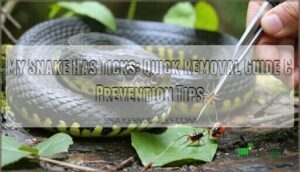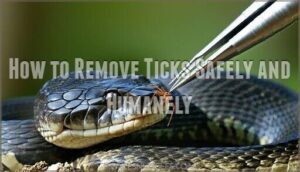This site is supported by our readers. We may earn a commission, at no cost to you, if you purchase through links.

You’ll notice small, dark bumps that weren’t there before. Remove them carefully with tweezers, grasping close to the skin and pulling straight out without twisting.
Never use matches, alcohol, or petroleum jelly—these old wives’ tales can harm your snake. Clean the bite site afterward and monitor for infection.
Most tick infestations happen when snakes are housed outdoors or with contaminated substrate. The good news? With proper technique and follow-up care, your scaly friend will bounce back quickly, and this is a very manageable issue, requiring only careful handling and follow-up care.
Table Of Contents
Key Takeaways
- Remove ticks immediately using fine-tipped tweezers – grasp close to your snake’s skin and pull straight out without twisting to avoid leaving mouthparts behind
- Clean and monitor bite sites with antiseptic solution and apply topical antibiotics to prevent infection, watching for signs of complications during healing
- Quarantine your snake for 2-3 months in a separate, easy-to-clean enclosure to prevent spreading ticks to other animals and monitor for missed parasites
- Maintain proper habitat hygiene by cleaning enclosures weekly, replacing substrate monthly, and controlling humidity levels to prevent future infestations
Tick Infestation in Snakes
Discovering ticks on your snake can be alarming, but it’s a manageable situation with the right approach.
These blood-sucking parasites are more common than you might think, affecting up to 30% of wild snake populations and occasionally finding their way onto pet snakes through contaminated environments or contact with other animals.
How Do Snakes Get Infested With Ticks?
Several factors put your snake at risk for tick infestations.
Poor habitat hygiene creates ideal conditions for ticks to thrive and reproduce.
Here’s how these unwelcome parasites find their way onto your reptile:
- Contaminated substrates – Infected bedding or decorations harbor tick eggs and larvae
- Direct contact – Snake-to-snake transmission spreads infestations quickly between animals
- Human error – We accidentally introduce ticks through clothing or equipment
- Compromised immunity – Stressed or sick snakes can’t fight off tick attachment effectively
- Wild exposure – Outdoor access increases contact with tick-infested vegetation and soil
Symptoms of Tick Infestation in Snakes
Your snake might show abnormal behavior like rubbing against objects, lethargy, or refusing food when dealing with tick infestation.
Look for infestation signs including tiny moving dots or swollen red areas on skin.
Snake irritation from tick attachment often causes increased water soaking and weight loss.
Skin lesions and scale deformities indicate tick borne diseases developing, requiring immediate attention for your snake’s health.
Health Risks Associated With Tick Infestation
Tick infestations pack a dangerous punch for your snake’s health.
These tiny blood-suckers can quickly drain your snake’s health and vitality.
Anemia risk skyrockets as these parasites drain blood, while immune suppression leaves your pet vulnerable to secondary infections.
Tick-borne diseases can trigger bacterial, fungal, or protozoal complications, causing severe skin damage and systemic illness.
Without prompt tick removal and tick infestation treatment, mortality rates climb substantially, making early intervention crucial for survival.
Understanding snake parasite risks is essential to provide proper care and prevent future infestations.
Removing Ticks From Your Snake
Finding ticks on your snake can be alarming, but quick action makes all the difference.
With the right tools and technique, you can safely remove these parasites and get your snake back to good health.
Steps to Remove Ticks From Your Snake
When you discover ticks on your snake, staying calm makes all the difference. Here’s your step-by-step snake tick removal guide:
Tick Removal Tools and Safe Extraction Process:
- Gather specialized tick tweezers and antibacterial solution before starting
- Position your snake securely to prevent sudden movements during removal
- Grasp the tick close to your snake’s skin using proper removal techniques
- Pull steadily in one swift motion to avoid leaving mouthparts behind
Complete Removal Steps:
- Clean the attachment site with antibacterial solution
- Use tick tweezers to grip the parasite near the skin
- Apply gentle, steady pressure for safe extraction
- Apply topical antibiotic to the bite area
Essential Aftercare Tips:
- Monitor the removal site for signs of infection
- Keep the area clean and dry during healing
- Watch for any unusual behavior in your snake
- Document the tick removal date and location
It’s also vital to practice safe snake handling to minimize the risk of snake bites and other injuries.
This systematic approach guarantees effective tick removal techniques while protecting your snake’s health throughout the process.
How to Remove Ticks Safely and Humanely
Now you’re ready to remove ticks with confidence. Use tick removal tools like fine-tipped tweezers or specialized tick tweezers for safe extraction. These humane methods guarantee proper tick removal techniques without harming your snake.
| Tool | Purpose |
|---|---|
| Fine-tipped tweezers | Precise grip near skin |
| Tick removal tools | Specialized safe extraction |
| Sterilized instruments | Prevent infection |
| Antiseptic solution | Post-removal care |
| Protective gloves | Handler safety |
Grasp ticks close to your snake’s skin and pull steadily upward—no twisting or jerking. This snake tick removal approach prevents mouthparts from breaking off. Effective tick removal requires using proper tick removal tools to minimize risks.
Aftercare and Follow-up Treatment
After tick removal, your snake’s recovery care begins with proper wound healing and post treatment monitoring.
Clean bite sites with antiseptic and apply topical antibiotics to prevent infection.
Maintain suitable humidity levels and provide nutritional support during snake aftercare.
Schedule follow up checks to watch for tick reinfestation and confirm your tick prevention measures are working effectively.
Treatment and Care for Ticks on Snakes
Once you’ve removed the ticks from your snake, proper treatment and ongoing care are essential for a full recovery.
You’ll need to address both the immediate wounds and prevent secondary infections while supporting your snake’s overall health during the healing process.
Topical and Medicinal Treatments for Ticks
After removing ticks, you’ll need proper treatment to prevent complications.
Here are three effective tick treatment options:
- Pyrethrin Sprays: These tick removal tools effectively kill remaining parasites, but follow dosage carefully to avoid toxicity.
- Ivermectin Treatment: This medicinal treatment targets tick infestations systemically, though veterinary consultation is essential before use.
- Antibiotic Creams: Apply these medicinal oils and topical treatments to bite sites, preventing secondary infections from tick removal wounds.
When using Pyrethrin Sprays, understanding pyrethrin spray products is vital for effective tick control.
Supportive Care for Snakes With Tick Infestations
Three pillars anchor your snake’s recovery: proper Nutritional Support, Hydration Management, and Stress Reduction.
A tick infestation weakens your pet, so focus on Wound Care and Humidity Control too.
| Care Component | Action Steps |
|---|---|
| Nutritional Support | Offer smaller, frequent meals; supplement vitamins if recommended |
| Hydration Management | Provide fresh water daily; monitor drinking habits closely |
| Stress Reduction | Minimize handling; maintain consistent temperature and lighting |
| Wound Care | Clean tick bite sites; apply topical antibiotics as directed |
Quarantine and Isolation Procedures
Isolation isn’t just about keeping your snake away from others—it’s your safety net against re-infestation.
After removing ticks, implement proper quarantine protocols to protect your entire collection. Snake segregation prevents cross-contamination while allowing you to monitor for tick infestation signs during recovery.
Set up a dedicated quarantine enclosure with:
- Complete enclosure sanitization using reptile-safe disinfectants
- Temperature and humidity controls matching your snake’s requirements
- Easy-to-clean surfaces like paper towels instead of substrate
- Separate feeding tools to prevent contamination spread
This isolation period typically lasts 2-3 months, giving you time to spot any missed ticks or new infestations. During snake quarantine, wash hands thoroughly between handling different animals. Monitor for recurring reptile tick problems—if you see new ticks, your snake tick removal wasn’t complete.
This systematic approach to infestation control protects your entire collection from these persistent parasites.
Preventing Tick Infestations in Snakes
Prevention is always better than treatment in the case of tick infestations in your snake.
By implementing proper environmental management and regular monitoring practices, you can substantially reduce the likelihood of these blood-sucking parasites taking up residence on your scaly companion.
This approach allows for effective management of tick infestations, making it a crucial part of snake care.
Maintaining a Clean and Hygienic Environment
A clean enclosure is your first line of defense against tick infestations.
Regular enclosure cleaning and habitat maintenance create an environment where ticks can’t thrive.
Disinfect all surfaces weekly, replace substrate monthly, and maintain proper ventilation.
Keep humidity levels balanced and monitor water quality daily.
These sanitation practices and environmental management steps make your snake’s home less hospitable to unwanted guests.
Effective snake enclosure cleaning is essential for maintaining a healthy environment.
Reducing The Risk of Tick Infestation
Beyond keeping Clean Enclosures, strategic Preventive Measures substantially reduce tick threats.
Apply reptile-safe Tick Repellents around habitat perimeters and use diatomaceous earth as natural barriers.
Smart Habitat Management includes controlling wild rodent populations nearby and installing fine mesh screens.
These tick prevention strategies, combined with proper Snake Hygiene practices, create an inhospitable environment for parasites while maintaining your snake’s comfort.
Effective snake mite infestation prevention requires understanding mite life cycles to implement targeted control measures.
Monitoring Your Snake for Signs of Ticks
Regular visual examination helps catch tick infestations early.
Check your snake’s body weekly, focusing on favorite hiding spots where ticks cluster. Look for tiny, dark specks moving on the skin—these parasites can be poppy-seed sized!
Watch for behavioral changes like lethargy, decreased appetite, or excessive rubbing against objects.
Early tick identification prevents serious health complications.
Veterinary Care for Snakes With Ticks
While most tick issues can be handled at home, certain situations require professional veterinary care to guarantee your snake’s health and recovery.
Severe infestations, signs of illness, or concerns about tick-borne diseases warrant immediate expert attention.
When to Seek Veterinary Attention
When tick symptoms spell trouble, don’t hesitate to seek Emergency Care.
Vet Visits become essential when your snake shows these warning signs:
- Lethargy, appetite loss, or abnormal behavior indicating systemic illness
- Respiratory distress or open-mouth breathing
- Severe swelling, discharge, or persistent skin irritation at tick removal sites
- Heavy tick infestation with visible weakness or anemia
Early veterinary care prevents life-threatening complications from snake health issues.
Regular checks for tick infestation signs can help identify potential problems before they become severe.
What to Expect From a Veterinary Visit
During your veterinary visit, you’ll witness a thorough evaluation that puts your snake’s health first.
The vet will perform a thorough snake examination, checking for visible ticks and evaluating overall condition.
They’ll discuss your pet’s history while conducting veterinary diagnosis procedures.
| Visit Component | What Happens |
|---|---|
| Initial Assessment | Physical exam and health history review |
| Tick Removal | Safe extraction using specialized tools |
| Medical Testing | Blood work to check for tick-borne diseases |
| Treatment Plans | Customized care strategy and medication options |
The veterinarian will explain tick infestation treatment options, including topical medications and supportive care.
They’ll provide reptile health tips for preventing future infestations and schedule follow-up care appointments.
Blood tests might reveal anemia or other complications requiring additional snake tick treatment.
You’ll leave with clear instructions for home care and confidence in your pet’s recovery plan.
Ongoing Care and Follow-up Appointments
Your snake’s recovery journey continues after the initial veterinary visit. Recovery Tips emphasize the importance of ongoing monitoring and Post Removal care to prevent complications.
- Follow Up appointments help track healing progress and catch potential issues early
- Monitor eating habits, behavior changes, and skin condition using Health Monitoring techniques
- Complete prescribed treatments and maintain Ongoing Support through proper husbandry practices
This snake tick management approach helps your pet bounce back stronger than ever. Regular veterinary check-ups are vital for maintaining good snake health care practices.
Frequently Asked Questions (FAQs)
Do snakes carry ticks?
Like a hitchhiker catching a ride, ticks absolutely latch onto snakes.
You’ll find these blood-sucking parasites on wild and captive snakes alike.
Research shows 30% of wild Australian snakes carry ticks, making infestations surprisingly common across species.
Are ticks dangerous on snakes?
Yes, ticks pose serious health risks to your snake.
They drain blood, causing anemia, weakness, and potential death if untreated.
Ticks also transmit diseases and create infection-prone wounds.
Quick removal and veterinary care prevent complications.
Do snakes eat ticks?
Coincidentally, you’re asking about nature’s cleanup crew!
You’re asking about a topic related to snakes and ticks, and it’s an interesting one because snakes don’t eat ticks – they’re blood-sucking parasites that attach to your snake’s skin.
Ticks feed on your snake’s blood, not the other way around. You’ll need to remove them manually with tweezers.
Are snakes parasitized by ticks?
Absolutely – ticks are significant parasites of snakes.
You’ll find them attached around the head, neck, and cloacal areas, feeding on blood and potentially transmitting diseases that can weaken or kill your snake.
How do you get rid of a tick on a snake?
Just like a skilled surgeon removing a splinter, you’ll carefully extract each tick using fine tweezers, grasping close to the skin and pulling straight out with steady pressure.
Clean the bite site with rubbing alcohol afterward, ensuring the area is properly disinfected after the steady removal process, and maintaining clean conditions to promote healing.
Do ball pythons have ticks?
Ball pythons can absolutely get ticks, just like other snake species.
These blood-sucking parasites attach to your python’s skin, causing irritation and potential health issues.
You’ll notice small, dark bumps or your snake rubbing against objects frequently if infected, which can be a clear sign of irritation.
How do you treat ticks on snakes?
Use tweezers to remove ticks with a firm, swift motion. Clean the area with antibacterial solution and apply topical antibiotic. Monitor for infection and consult a veterinarian for severe infestations.
Do ticks harm snakes?
Yes, ticks seriously harm snakes through blood loss, anemia, disease transmission, and weakened immunity. Heavy infestations can cause lethargy, infection, and even death if you don’t treat them promptly.
What should I do if my snake has mites?
Mite mayhem requires immediate intervention! You’ll need to quarantine your snake, increase humidity levels, and apply veterinary-approved treatments like pyrethrin sprays or ivermectin.
Clean the enclosure thoroughly and monitor closely for signs of improvement.
Do ticks infest snakes?
Ticks absolutely infest snakes, affecting up to 30% of wild populations. These blood-sucking parasites attach around the head, neck, and cloacal areas, causing anemia, infections, and potentially death if untreated.
Conclusion
Fighting ticks on your snake is like battling unwelcome guests who’ve overstayed their welcome.
When you discover "my snake has ticks," swift action prevents complications. You’ve learned proper removal techniques, aftercare protocols, and prevention strategies.
Regular health checks catch infestations early, while clean environments reduce risks.
Remember: patience and gentle handling protect both you and your serpent.
With consistent monitoring and proper technique, you’ll keep your scaly companion healthy and tick-free for years ahead.
- https://www.reptileadvisor.com/snake-mites/
- https://www.cdc.gov/ticks/hcp/data-research/tickborne-disease-reference-guide/index.html
- https://newsnetwork.mayoclinic.org/discussion/mayo-clinic-minute-ticks-and-the-diseases-they-carry/
- https://www.facebook.com/Goldcoastsnakecatcher/posts/993044040890459?__xts__%5B0%5D=68.ARD85nCuM386hCGpjJP67VQ4PSA7ESS8F7GyOwMfnqZ1yLxBsnyR8Lincy_f9pMtc5O_qjoZVyM1DY0yY6tUKJTPZldSmBtpWZisMHxuyjkoJtGdgomnD2yTerZUSo2sE3FULbhreIYKy8y0yCtGxnQZlw9fFVN3CS0HQU61HZ4SBHN5EPX6xRUhOsfnny4eT6ihX7e3AavA0oRq_cYEIhtFPkZVXPLi_rH8KcS4PY_5SNVJvFMrXR6goDmE9ERSK9jOaiM2S0Zg-iOMA9F3RW4iPgJ7hE0AEuWFMv31q3BykqjHrFo8m4nsEW4eAjWs4mwOLO6aDnB9Ucn1N3HBYbU&__tn__=-R
- https://meridian.allenpress.com/jhms/article/10/3/4/137263/The-Biology-Clinical-Significance-and-Control-of














